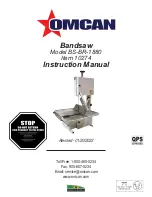
ENGLISH
38
Blade Installation and Removal
(fi g. 8, 9A, 9B, 9C)
WARNING:
To reduce the risk
of serious personal injury, place
the lock-off button in the lock-
off position or turn tool off and
disconnect battery pack before
making any adjustments or
removing/installing attachments or
accessories.
An accidental start-up
can cause injury.
Different blade lengths are available. Use the
appropriate blade for the application. The blade
should be longer than 3-1/2" (89 mm) and should
extend past the shoe and the thickness of the
workpiece during the cut. A 4" (102 mm) blade is
recommended for best performance. Do not use
jigsaw blades with this tool.
WARNING:
Cut hazard. Blade breakage
may occur if the blade does not extend
past the shoe and the workpiece during
the cut (fig. 8). Increased risk of personal
injury, as well as damage to the shoe
and workpiece may result.
TO INSTALL BLADE INTO SAW (FIG. 9A, 9B, 9C)
1. Pull blade clamp release lever (g) up.
2. Insert the blade shank into the blade clamp
(f, fig. 9C).
3. Close blade clamp release lever.
4. Note that the blade can be installed upside-
down to assist in flush-to cutting (refer to
fig. 9B).
TO REMOVE BLADE FROM SAW (FIG. 9A, 9B, 9C)
CAUTION:
Burn hazard. Do not touch
the blade immediately after use. Contact
with the blade may result in personal
injury.
1. Pull blade clamp release lever (g) up.
2. Remove blade.
Worklight (fi g. 9C)
The worklight (e) is located below the blade clamp
(f) behind the shoe. The worklight will be activated
when the trigger switch is squeezed.
NOTE:
The worklight is for lighting the immediate
work surface and is not intended to be used as a
flashlight.
Cutting (fi g. 9B, 10–13)
WARNING:
Always use eye protection.
All users and bystanders must wear eye
protection that conforms to ANSI Z87.1.
WARNING:
Exercise extra caution
when cutting towards operator. Always
hold saw firmly with both hands while
cutting.
Before cutting any type of material, be sure it is firmly
anchored or clamped to prevent slipping. Place
blade lightly against work to be cut, switch on saw
motor and allow it to obtain maximum speed before
applying pressure. Whenever possible, the saw shoe
must be held firmly against the material being cut.
This will prevent the saw from jumping or vibrating
and minimize blade breakage. Any cuts which put
pressure on the blade such as angle or scroll cuts
increase potential for vibration, kickback and blade
breakage.
WARNING:
Use extra caution when
cutting overhead and pay particular
attention to overhead wires which may
be hidden from view. Anticipate the path
of falling branches and debris ahead of
time.
WARNING:
Inspect work site for hidden
gas pipes, water pipes or electrical wires
before making blind or plunge cuts.
Failure to do so may result in explosion,
property damage, electric shock, and/or
serious personal injury.
FLUSH-TO CUTTING (FIG. 9B, 10)
The compact design of the saw motor housing and
spindle housing permits extremely close cutting to
floors, corners and other difficult areas. The blade
should be inserted upside-down to assist in flush-
cutting (fig. 9B).
POCKET/PLUNGE CUTTING – WOOD ONLY (FIG. 11)
The initial step in pocket cutting is to measure the
surface area to be cut and mark clearly with a
pencil, chalk or scriber. Use the appropriate blade
for the application. The blade should be longer than
3-1/2" (89 mm) and should extend past the shoe
and the thickness of the workpiece during the cut.
A 4" (102 mm) blade is recommended for best
performance. Insert blade into the blade clamp.
Next, tip the saw backward until the back edge
of the shoe is resting on the work surface and the
blade clears the work surface. Then, squeeze the
trigger switch and allow saw to come up to speed.
Grip saw firmly with both hands and begin a slow,
deliberate upward swing with the handle of the saw,
keeping the bottom of the shoe firmly in contact with
the workpiece. Blade will begin to feed into material.
















































